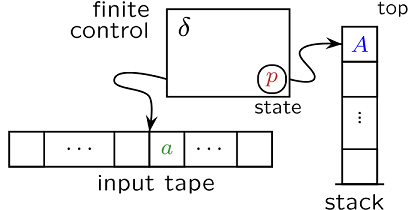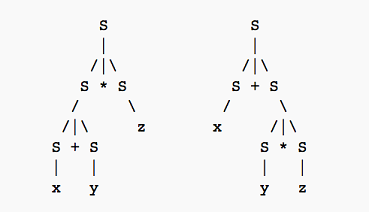- Finite state automation
- Pushdown automation
- Context-free grammars
- Minimal acyclic subsequential transducer
1-3 are developed for the Languages, Automata and computability course at the Faculty of Mathematics and Informatics, Sofia university. All algorithms are direct implementations of the shown constructions here and may not have optimal time and space complexity
4 is developed for an advanced course of the same topic and it's tested with real-world data.
1-3 and 4 should be compiled separatly!
| Syntax: | Effect: | Example: |
|---|---|---|
| load [config_file] | loads configuration from a file. Example files in Example_config_files | load myfsa.fst |
| environment fsa | prints information for all registered fsa-s | environment fsa |
| regex [fsa1] | returns a regex for the automation. | regex a1 |
| fsa [name] | registers an automation with one state with this name. | fsa test1 |
| fsa [name] [regex] | registers an automation with this name for this regex. | fsa test2 a*(a+b)*b |
| print [name] | prints the automation. | print test1 |
| vis [name] | generates an html file with an image of the automation. | vis test1 |
| accepts [fsa] [string] | returns true if the fsa accepts the string and false otherwise | accepts a1 aabbb |
| add_state [fsa] | adds a new state to the automation | add_state a1 |
| make_final [fsa] [state] | makes the state final | make_final a1 0 |
| arc [fsa] [start] [end] [symbol] | adds a new transition from state start to state end with this symbol | arc a1 0 1 a |
| det [fsa] | fsa becomes deterministc | det a1 |
| [fsa1] = det [fsa] | registers an automation fsa1 which is the deterministic fsa2 | a1 = det a |
| min [fsa] | fsa becomes deterministic, total and minimal | min a1 |
| [fsa1] = min [fsa] | registers an automation fsa1 which is the deterministic and minimal fsa2 | a1 = min a2 |
| [fsa1] = union [fsa2] [fsa3] | registers an automation fsa1 which is the union of fsa2 and fsa3 | a1 = union a2 a3 |
| [fsa1] = concat [fsa2] [fsa3] | registers an automation fsa1 which is the concatenation of fsa2 and fsa3 | a1 = concat a2 a3 |
| [fsa1] = intersect [fsa2] [fsa3] | registers an automation fsa1 which is the intersection of fsa2 and fsa3 | a1 = intersect a2 a3 |
| star [fsa1] | fsa1 becomes an new automation for the Kleene star of the old fsa1 automation | star a1 |
| [fsa1] = star [fsa2] | registers an automation fsa1 which is the Kleene star of fsa2 | a1 = star a2 |
| compl [fsa1] | fsa1 becomes an new automation for the complement of the old fsa1 automation | compl a1 |
| [fsa1] = compl [fsa2] | registers an automation fsa1 which is the complement of fsa2 | a1 = compl a2 |
| reverse [fsa1] | fsa1 becomes an new automation for the reverse of the old fsa1 automation | reverse a1 |
| [fsa1] = reverse [fsa2] | registers an automation fsa1 which is the reverse of fsa2 | a1 = reverse a2 |
| regex [fsa1] | returns a regex for the automation. | regex a1 |
| environment npda | prints information for all registered npda-s | environment npda |
| npda [name] | registers an Pushdown automation with one state with this name. | npda test1 |
| add_state [npda] | adds a new state to the npda | add_state test1 |
| make_final [npda] [state] | makes the state final | make_final test1 0 |
| arc [npda] [start] [symbol] [stack_top] [end] [replace_stack] | adds a new transition from state start to state end | arc test1 0 a # 0 A# |
| accepts [npda] [string] | returns true if the npda accepts the string and false otherwise | accepts test1 aabbb |
| cfg [name] [rules] | Creates a context-free grammer. The rules are separated with a space. | cfg test1 S->aSb|$ |
The FST system supports automata visualization. The command is called vis.
The files header.x, footer.x and the graphVisualiser_files folder should be in the same folder as the executable.
This commands generates a html file (with the name of the automation). You can find it in the main folder.
The html file looks like this:
Press the single button on the html page and the automation will be visualized.
Finite state automation is A = <Q,Σ,s,F,δ>, where
Q - is a finite, non-empty set of states
Σ- is the input alphabet (a finite, non-empty set of symbols).
s - is an initial state, an element of Q
F- is the set of final states, a subset of Q
δ- is the state-transition function
Diffrent ways of creating an automation:
int main()
{
// Automation for a(a+b)*
FiniteStateAutomation A("a(a+b)*");
std::string computation;
cout << A.accepts("abbb", computation) << endl; //true;
cout << A.accepts("bbba", computation) << endl; //false
FiniteStateAutomation A2; //Only one state with index 0
A2.addState(); //Adds state with index 1
A2.addTransition({"0", "1", "a"});
A2.addTransition({"1", "1", "a"});
A2.addTransition({"1", "1", "b"});
return 0;
}| addState() | Adds a new state. Returns the index of the new state. |
| addTransition(start,end,ch) | Creates a new transition from state start to state end with the letter ch. May become from DFA to NFA. |
| changeStartState(newStart) | Changes the start state of the automation. Returns false if the given new start state doesn’t exist and true if it was successful. |
| makeStateFinal(state) | Marks the given state as final. Returns false if the state doesn’t exist. |
| accepts(word, computation, shouldReturnComputation) | Returns true if the word is accepted by the DFA/NFA. If the third parameter is true, then the computation will contain the successful (if such exists) path |
| isEmptyLanguage() | Returns true if the FSA doesn't accept any strings. |
| removeNotReachableStates() | Removes all states that are not reachable from the start state.. |
| makeTotal() | Makes the automation complete. It shoud define a transition for each state and each input symbol. We create an error state for every non-existing transition. |
| makeDeterministic() | Makes the Non-deterministic finite automaton(NFA) to Deterministic finite Automation(DFA). |
| minimize() | Transforms the given DETERMINISTIC finite automaton into an equivalent DFA that has a minimum number of states. |
| getRegEx() | Gets a regular expression for the language accepted by the NFA. The regular expression may be non-practical as it becomes long very fast. |
| Union(A1,A2) | Concat(A1,A2) | KleeneStar(A1) | Complement(A1) | Intersect(A1,A2) | Reverse(A1) |
#include "FiniteStateAutomation.h"
int main()
{
//Regex: a(a+b)*b + b(a+b)*a
FiniteStateAutomation A("a(a+b)*b+b(a+b)*a");
A.print(); //Image 1 and 2
A.minimize();
A.print(); // Image 3 and 4.
return 0;
}
The first print:
Without the unreachable states it looks like:
And after minimizing the automation, the second print:
It looks like this:
int main()
{
// FSA for ab(a+b)*
FiniteStateAutomation A("ab(a+b)*");
A.minimize(); //better to be minimized, so the regex would be simple.
A.print();
cout << A.getRegEx();
return 0;
}Here is the FSA:
And the result:
ab+(ab(a+b)*(e+a+b))
= ab + (ab(a+b)*) (since e,a and b are in (a+b)*)
= ab(a+b)* (since ab is in ab(a+b)*)
.Non-deterministic Pushdown Automation is P = <Q,Σ,G,#, s,F,δ>, where
Q - is a finite, non-empty set of states
Σ- is the input alphabet (a finite, non-empty set of symbols).
G- finite set which is called the stack alphabet.
# - initial stack symbol.
s - is an initial state, an element of Q
F- is the set of final states, a subset of Q
δ- is the transition function
! The empty string/symbol is $ !
Each rule(transition) looks like this:
<current state, read symbol from the tape, top of the stack, destination state, string to replace the top of stack>
- Example 1: <0,'a', 'A', 1, "BA"> From state 0 to state 1, we push B to the stack
- Example 2: <0,'b', 'A', 3, "$"> From state 0 to state 3, we pop A from the stack (since $ is the empty string)
Example for NPDA for { ww^rev | w in {a,b} }*
// Example for Nondeterministic pushdown automata for { ww^rev | w in {a,b}* }
int main()
{
NPDA PA(3); //3 initial states
PA.makeStateFinal(2);
PA.addTransition({ "0", "a", "#", "0", "A#" });
PA.addTransition({ "0", "b", "#", "0", "B#" });
PA.addTransition({ "0", "$", "#", "2", "$" });
PA.addTransition({ "0", "a", "A", "0", "AA" });
PA.addTransition({ "0", "a", "A", "1", "$" });
PA.addTransition({ "0", "b", "B", "0", "BB" });
PA.addTransition({ "0", "b", "B", "1", "$" });
PA.addTransition({ "0", "b", "A", "0", "BA" });
PA.addTransition({ "0", "a", "B", "0", "AB" });
PA.addTransition({ "1", "a", "A", "1", "$" });
PA.addTransition({ "1", "b", "B", "1", "$" });
PA.addTransition({ "1", "$", "#", "2", "$" });
string computation;
std::cout << PA.accepts("abba", computation) << std::endl; //true
std::cout << PA.accepts("abbb", computation) << std::endl; //false
std::cout << PA.accepts("aaabbbbbbaaa", computation) << std::endl; //true
}
We can input out context-free grammar (CFG) and it will simulate it using NPDA.
Example for simulating the CFG:
S->aSc|B
B->bB|$
int main()
{
//Example Nondeterministic pushdown automata from a context-free grammar
// S->aSc | B
// B->bB | $
// L(S) = { a^n b^k c^n | n,k \in N}
ContextFreeGrammar cfg;
cfg.grammarRules.push_back("S->aSc|B");
cfg.grammarRules.push_back("B->bB|$");
NPDA PA2(cfg);
std::cout << PA2.accepts("abc", true) << std::endl; //true
std::cout << PA2.accepts("aaaaaabbbbcccccc") << std::endl; //true
std::cout << PA2.accepts("abcc") << std::endl; //false
}The project contains algorithms for creating and maintaining a minimal acyclic subsequential transducer for a finite function f : Σ* -> N
(MAST for [a, 11], [ab, 3], [ac, 1])
The project consist of three functions:
- Building and MAST from a given sorted list of pairs <key, value>. It follows the aproach in [Mihov and Maurel, 2001] Mihov, S. and Maurel, D. (2001). Direct construction of minimal acyclic subsequential transducers.
- Inserting words to the MAST from a given list of pairs
- Removing words to the MAST from a given list of pairs
All the algorithms can be easy modified for a function of the type f : Σ* -> Σ*
The check for equivalent states is done with a proper hash. Each state is hashed using it's transitions, output and finality. More information about the hash on SubsequentialTransducer.h:18















